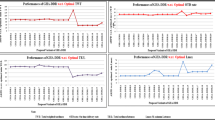Abstract
This paper presents a parallel machine scheduling problem with process quality, due dates, and sequence-dependent setup times. The process capability indices are utilized to measure the process quality level between job and machine. The dispatching algorithm named quality and rework with due dates (QRD) is proposed in this paper focusing on the rework processes due to quality issue. The performance of QRD is measured by two ways: one is quality-related performance indicator—process capability index—and the other is due date related ones: maximum lateness, mean flow time, and the number of reworks. A large number of test problems are randomly generated to evaluate the performance of the proposed algorithm. Computational results show that the proposed algorithm is significantly superior to existing dispatching algorithms for the test problems.
Similar content being viewed by others
References
Hsieh JC, Chang PC, Hsu LC (2003) Scheduling of drilling operations in printed circuit board factory. Comput Ind Eng 44:461–473
Shin HJ, Kang YH (2010) A rework-based dispatching algorithm for module process in TFT-LCD manufacture. Int J Prod Res 48:915–931
Flapper SDP, Fransoo JC, Broekmeulen RACM, Inderfurth K (2002) Planning and control of rework in the process industries: review. Prod Plan Control 13:26–34
Lee HL (1992) Lot sizing to reduce capacity utilization in a production process with defective items, process corrections and rework. Manag Sci 38:1314–1328
Liu JJ, Yang P (1996) Optimal lot-sizing in an imperfect production system with homogeneous reworkable jobs. Eur J Oper Res 91:517–527
Kim CH (2005) An EMQ model with rework. J Korean Inst Ind Eng 31:173–179
Shin JS, Han JY, Jeong BJ (2006) Comparative analysis of rework policies in multistage production system. J Korean Inst Ind Eng 32:29–41
Teunter RH, Flapper SDP (2003) Lot-sizing for a single-product production system with rework of perishable production defectives. OR Spectr 25:85–96
Zargar AM (1995) Effect of rework strategies on cycle time. Comput Ind Eng 29:239–243
Agnihorthri SR, Kenett RS (1995) The impact of defects on a process with rework. Eur J Oper Res 80:308–327
Sha DY, Hsu SY (2004) The effects of rework on the shopfloor control in wafer fabrication. J Manuf Technol Manag 15:184–198
Flapper SDP, Teunter RH (2004) Logistic planning of rework with deteriorating work in process. Int J Prod Econ 88:51–59
Lee DH, Ko HH, Kim SS (2005) A study of strategy for planning of rework in semiconductor monitoring burn in test process. IE Interfaces 18:350–360
Kuhl ME, Laubisch GR (2004) A simulation study of dispatching rules and rework strategies in semiconductor manufacturing. Adv Semicond Manuf ASMC '04. IEEE Conf Work 325–329
Sha DY, Hsu SY, Che ZH, Chen CH (2006) A dispatching rule for photolithography scheduling with an online rework strategy. Comput Ind Eng 50:233–247
Ko HH, Kim JH, Kim SS, Baek JG (2010) Dispatching rule for non-identical parallel machines with sequence-dependent setups and quality restrictions. Comput Ind Eng 59:448–457
Porter LJ, Oakland JS (1991) Process capability indices—an overview of theory and practice. Qual Reliab Eng Int 7:437–448
Tang LC, Than SE (1999) Computing process capability indices for non-normal data: a review and comparative study. Qual Reliab Eng Int 15:339–353
Juran AM, Gryna FM (1980) Quality planning and analysis, 2nd edn. McGraw-Hill, New York, pp 70–105
Montgomery D (2004) Introduction to statistical quality control. Wiley, New York, pp 28–41
Booker JM, Raines M, Swift KG (2001) Designing capable and reliable products. Butterworth-Heinemann, Oxford, pp 57–98
Lee YH, Pinedo M (1997) Scheduling jobs on parallel machines with sequence-dependent setup times. Eur J Oper Res 100:464–474
Author information
Authors and Affiliations
Corresponding author
Rights and permissions
About this article
Cite this article
Shin, H.J. A dispatching algorithm considering process quality and due dates: an application for re-entrant production lines. Int J Adv Manuf Technol 77, 249–259 (2015). https://doi.org/10.1007/s00170-014-6436-9
Received:
Accepted:
Published:
Issue Date:
DOI: https://doi.org/10.1007/s00170-014-6436-9




